

Plants in Desert. As of July 1, 2013 ThinkQuest has been discontinued.

We would like to thank everyone for being a part of the ThinkQuest global community: Students - For your limitless creativity and innovation, which inspires us all. Teachers - For your passion in guiding students on their quest. Partners - For your unwavering support and evangelism. Pussypaws, Sand Cress, Calyptridium monandrum.
Color: Yellow Color: Pink to reddish Common name: Pussypaws, Sand Cress Latin name: Calyptridium monandrum Family: PORTULACACEAE Height: .5-7 inches Description: The flowers are narrowly white-margined with 3 petals, 1–3 mm; pink to reddish.
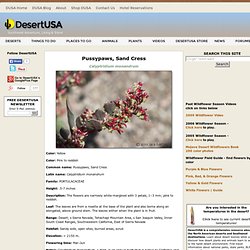
Leaf: The leaves are from a rosette at the base of the plant and also borne along an elongated, above ground stem. Basic Facts About San Joaquin Kit Foxes. The tiny and secretive San Joaquin kit fox is one of the most endangered animals in California.

The kit fox is the size of a housecat, with big ears, a long bushy tail and furry toes that help to keep it cool in its hot and dry Central Valley environment. They are difficult to spot with their buff, tan or yellowish-grey fur. Diet Kit foxes primarily eat rodents and other small animals, including black-tailed hares, desert cottontails, mice, kangaroo rats, squirrels, birds and lizards.
Kit foxes do not need to drink water since their prey provides enough liquid for them to survive. Population No one knows historic population numbers for the San Joaquin kit fox. Range Did You Know? Kit foxes are the smallest canid species in North America, though San Joaquin kit fox is the largest subspecies. The San Joaquin kit fox was originally found throughout most of the San Joaquin Valley in Central California.
Behavior The San Joaquin kit fox is active mostly at night. Reproduction Get More Information. Desert animals. Desert. Desert Biomes. In this report you will learn about Hot and Dry Deserts and Cold Deserts.
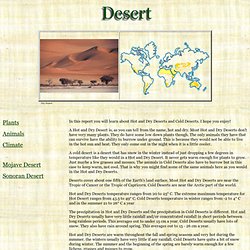
I hope you enjoy! A Hot and Dry Desert is, as you can tell from the name, hot and dry. Most Hot and Dry Deserts don't have very many plants. They do have some low down plants though. The only animals they have that can survive have the ability to burrow under ground. A cold desert is a desert that has snow in the winter instead of just dropping a few degrees in temperature like they would in a Hot and Dry Desert. Deserts cover about one fifth of the Earth's land surface. Desert Protective Council. How many desert maps are there. The Roadrunner. The legendary roadrunner bird is famous for its distinctive appearance, its ability to eat rattlesnakes and its preference for scooting across the American deserts, as popularized in.
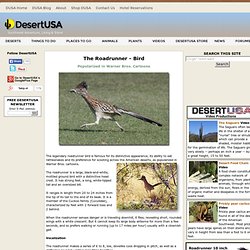
Deserts. Far from being barren wastelands, deserts are biologically rich habitats with a vast array of animals and plants that have adapted to the harsh conditions there.

Some deserts are among the planet's last remaining areas of total wilderness. Yet more than one billion people, one-sixth of the Earth's population, actually live in desert regions. Deserts cover more than one fifth of the Earth's land, and they are found on every continent. A place that receives less than 10 inches (25 centimeters) of rain per year is considered a desert. Formation of Deserts. As of July 1, 2013 ThinkQuest has been discontinued.

We would like to thank everyone for being a part of the ThinkQuest global community: Students - For your limitless creativity and innovation, which inspires us all. Teachers - For your passion in guiding students on their quest. Partners - For your unwavering support and evangelism. Parents - For supporting the use of technology not only as an instrument of learning, but as a means of creating knowledge. We encourage everyone to continue to “Think, Create and Collaborate,” unleashing the power of technology to teach, share, and inspire. Best wishes, The Oracle Education Foundation. Blue Planet Biomes - World Biomes. What is a Biome?
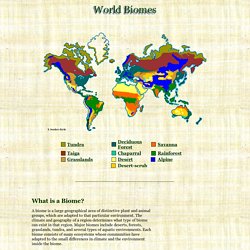
A biome is a large geographical area of distinctive plant and animal groups, which are adapted to that particular environment. The climate and geography of a region determines what type of biome can exist in that region. Major biomes include deserts, forests, grasslands, tundra, and several types of aquatic environments. Each biome consists of many ecosystems whose communities have adapted to the small differences in climate and the environment inside the biome.
All living things are closely related to their environment. The earth includes a huge variety of living things, from complex plants and animals to very simple, one-celled organisms. Welcome to the Desert. Facts about the DESERT. DESERT#3. Desert climate. An area that features this climate usually experiences less than 250 mm (10 inches) per year of precipitation and in some years may experience no precipitation at all.
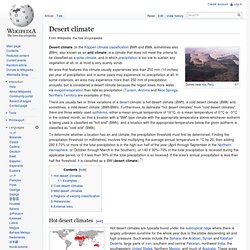
In some instances, an area may experience more than 250 mm of precipitation annually, but is considered a desert climate because the region loses more water via evapotranspiration than falls as precipitation (Tucson, Arizona and Alice Springs, Northern Territory are examples of this). To determine whether a location has an arid climate, the precipitation threshold must first be determined. Hot desert climates[edit] Regions with hot desert climates Hot desert climates are typically found under the subtropical ridge where there is largely unbroken sunshine for the whole year due to the stable descending air and high pressure.
Desert Climate.